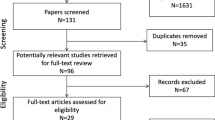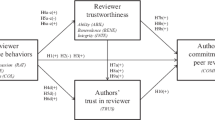Abstract
Authors have various motivations in citing references during scientific production. The study of these motivations has led to the introduction of different theories like normative theory and social constructive theory of citing behavior. Using the social constructive approach to citing behavior, this research introduces citing conformity whereby some authors’ social, personal or non professional citing behaviors are determined by societal pressure. This is explained at three levels namely; normative, informational and identification. This paper aims to design, validate and determine the reliability of a questionnaire to measure citing conformity at these three levels. In order to devise the instrument, a questionnaire with 45 items was preliminarily designed. After face validity of the questionnaire had been determined by ten scholars, data was gathered. 150 Iranian authors with at least two articles indexed in Arts and Humanities Citation Index (AHCI) or Social Science Citation Index (SSCI) during the period 2001–2010 were selected using systematic random allocation and were asked to fill out the questionnaire. Exploratory factor analysis was used to analyze the data. Factor analysis was administered using principal components analysis (PCA) with Varimax rotation, eigenvalue more than one, and factor loading 0.45 to extract three factors. Out of 45 items, 11 were deleted by the software due to low factor loading. The remaining 34 items were retained and constitute tree factors: normative (13 items), informational (13 items), and identification (8 items). KMO coefficient test was 0.726 and Bartlett sphericity index was 2431.91 (P < 0.0001) which proved the sufficiency of sample size and the reliability of the test. Cronbach’s alpha was employed to determine the reliability of this instrument. Cronbach’s alpha coefficient for normative, informational and identification conformities was 0.86, 0.81 and 0.85 respectively. Therefore, the reliability of all the factors was acceptable with approximately high coefficients. As the Cronbach’s alpha coefficients convey, the reliability of all factors was acceptable. The development of a citing conformity instrument at normative, informational and identification levels, provides a scale to measure authors’ citing behavior in social, personal or non professional aspects according to the above mentioned psychological variables (normative, informational and identification conformities). Therefore, this instrument will be able to explain the authors’ citing behavior and motivations in a large extent of a subject area.
Similar content being viewed by others
References
Adams, J. (2005). Early citation counts correlate with accumulated impact. Scientometrics, 63(3), 567–581.
Aronson, E. (2008). Social psychology [in Persian] (H. ShokrKon, Trans.). Tehran: Ravan.
Asch, S. E. (1951). Effects of group pressures upon the modification and distortion of judgments. In G. E. Swanson, T. M. Newcomb, & E. L. Hartley (Eds.), Readings in social psychology (pp. 393–401). New York: Holt, Reinhart & Winston.
Asch, S. E. (1955). Studies of independence and conformity: a minority of one against a unanimous majority. Psychological Monographs, 70, 9.
Baron, R. A., Byrne, D., & Branscomb, N. R. (2009). Social psychology [in Persian] (Y. Karimi, Trans.). Tehran: Ravan.
Bedar, L., Deziel, J., & Lamarche, L. (2005). Social psychology [in Persian] (H. Ganji, Trans.). Tehran: Savalan.
Bonzi, S., & Snyder, H. W. (1991). Motivations for citation: A comparison of self citation and citation to others. Scientometrics, 21(2), 245–254.
Bornman, L., & Daniel, H. D. (2008). What do citation counts measure? A review of studies on citing behavior. Journal of Documentation, 64(1), 45–80.
Bothner, M. S., Haynes, R., Lee, W., & Smith, E. B. (2010). When do Matthew effects occur? Journal of Mathematical Sociology, 34, 80–114.
Burrell, Q. L. (2003). Predicting future citation behavior. Journal of the American Society for Information Science and Technology, 54, 372–378.
Cano, V. (1989). Citation behavior: Classification, utility, and location. Journal of the American Society for Information Science, 40, 284–290.
Case, D. O., & Miller, J. B. (2011). Do bibliometricians cite differently from other scholars? Journal of the American Society for Information Science and Technology, 62(3), 421–432.
Cinnirella, M., & Green, B. (2007). Does cyber-conformity vary cross-culturally? Exploring the effect of culture and communication medium on social conformity. Computers in Human Behavior, 23, 2011–2025.
Cozzens, S. E. (1985). Comparing the sciences-citation context analysis of papers from neuropharmacology and the sociology of science. Social Studies of Science, 15, 127–153.
Cronin, B. (2005). The hand of science: Academic writing and its rewards. Lanham, MD: Scarecrow Press.
Ebrahimy, S. (2012). A study of correlation between citing conformity in three levels of normative, informational and identification with Iranian authors citing behavior patterns through fields of humanities and social science. PhD Thesis in Knowledge & Information Science, Shahid Chamran University, Ahvaz, Iran.
Garfield, E. (1981). Citation classics—Four years of the human side of science. Current Contents, 22, 5–16.
Haslam, N., Ban, L., Kaufman, L., Loughnan, S., Peters, K., Whelan, J., et al. (2008). What makes an article influential? Predicting impact in social and personality psychology. Scientometrics, 76(1), 169–185.
Kelman, H. C. (1958). Compliance, identification, and internalization: Three processes of attitude change. Journal of Conflict Resolution, 2, 51–60.
Kim, K. (2004). The motivation for citing specific references by social scientists in Korea: The phenomenon of co-existing references. Scientometrics, 59(1), 79–93.
Levitt, J. M., & Thelwall, M. (2008). Patterns of annual citation of highly cited articles and the prediction of their citation ranking: A comparison across subjects. Scientometrics, 77(1), 41–60.
Lotfi, H. (2002). Social psychology, conformity psychology. Tehran: Moallef. (in Persian).
Mehrabian, A. (2005). Manual for the conformity scale. Monterey, CA: University of California, Los Angeles.
Merton, R. K. (1988). The Matthew effect in science, II: Cumulative advantage and symbolism of intellectual property. ISIS, 79, 606–623.
Miller, J. B. (2002). Impact factors and publishing research. Scientist, 16, 11.
Moed, H. F. (2008). Citation analysis in research evaluation [in Persian] (M. Abbas & H. Mokhtari, Trans.). Tehran: Chapar.
Mohammadi, M., & Mottaghi Dadgar, A. (2007). Citation analysis of papers published in 30 no of library and information science journal, 1997–2005. Library and Information Science, 10, 1.
Pastercamp, G., Rotmans, J. I., Kleijn, D. V. P., & Borst, C. (2007). Citation frequency: A biased measure of research impact significantly influenced by the geographical origin of research articles. Scientometrics, 70(1), 153–165.
Rabow, H. (2005).The discovery of discoveries: Exploring the dissemination of major findings in the life science. In P. Ingwersen, & B. Larsen (Eds.), Proceedings of the 10th International Conference of the International Society for Scientometrics and Informetrics. Karolinska University Press, Stockholm.
Sevinc, A. (2004). Manipulating impact factor. An unethical issue or an editors choice? Swiss Medical Weekly, 134, 410.
Shadish, W. R., Tolliver, D., Gray, M., & Sengupta, S. K. (1995). Author judgments about works they cite-three studies from psychology journals. Social Studies of Science, 25, 477–498.
Shahriari, P. & Osareh, F. (2003). The final report of project, citation analysis of information science journal papers. Tehran: Iranian research institute for information science and technology.
Vartanian, L. R., & Hopkinson, M. M. (2010). Social connectedness, conformity, and internalization of societal standards of attractiveness. Body Image., 7, 86–89.
Vinkler, P. (1987). A quasi-quantitative citation model. Scientometrics, 12, 47–72.
Vinkler, P. (1998). Comparative investigation of frequency and strength of motives toward referencing. The reference threshold model. Scientometrics, 43(1), 59–67.
Vinkler, P. (2010). The evaluation of research by scientometric indicators. Oxford: Chandos Publishing.
Walters, G. D. (2006). Predicting subsequent citations to articles published to twelve crime psychology journals. Scientometrics, 69(3), 499–510.
Wang, J. & Lin, J. (2003). Are personalization systems really personal? Effects of conformity in reducing information overload, HICSS, vol. 7, p. 222. 36th Annual Hawaii International Conference on System Sciences. Retrieved June 24, 2010, from http://www.computer.org/portal/web/csdl/doi/10.1109/HICSS.2003.1174587.
Wang, F., Qiu, J., & Yu, H. (2012). Research on the cross-citation relationship of core authors in scientometrics. Scientometrics, 91(3), 1011–1033.
White, H. D. (2001). Authors as citers over time. Journal of the American Society for Information Science and Technology, 52, 87–108.
White, H. D. (2004). Reward, persuasion, and the Sokal Hoax: A study in citation identities. Scientometrics, 60(1), 93–120.
Author information
Authors and Affiliations
Corresponding author
Rights and permissions
About this article
Cite this article
Ebrahimy, S., Osareh, F. Design, validation, and reliability determination a citing conformity instrument at three levels: normative, informational, and identification. Scientometrics 99, 581–597 (2014). https://doi.org/10.1007/s11192-013-1188-0
Received:
Published:
Issue Date:
DOI: https://doi.org/10.1007/s11192-013-1188-0




